MP Board Class 12th Biology Important Questions Chapter 5 Principles of Inheritance and Variation
Principles of Inheritance and Variation Important Questions
Principles of Inheritance and Variation Objective Type Questions
Question 1.
Choose the correct answers:
Question 1.
What is the homozygous ratio of F2 generation in incomplete dominance :
(a) 3 : 1
(b) 1 : 2 : 1
(c) 1 : 1 : 1 : 1
(d) 2 : 2
Answer:
(b) 1 : 2 : 1
Question 2.
Functional unit of inheritance is :
(a) Cistron
(b) Gene
(c) Chromosomes
(d) Intron
Answer:
(b) Gene
Question 3.
Character which is not seen in first generation is called :
(a) Dominance
(b) Recessive
(c) Special
(d) Normal
Answer:
(b) Recessive
Question 4.
Person consists of heterozygous allele is called :
(a) Homozygous
(b) Heterozygous
(c) Dioecious
(d) Hermaphrodite.
Answer:
(b) Heterozygous
![]()
Question 5.
Exception of Mendel’s Law is :
(a) Law a independent assortment
(b) Law of segregation
(c) Law of dominance
(d) Law of linkage.
Answer:
(d) Law of linkage.
Question 6.
In which process recombination may occur :
(a) Cytokinesis
(b) Spindle formation
(c) Crossing over
(d) Chromosome replication.
Answer:
(c) Crossing over
Question 7.
In which chromosome numbers are normal :
(a) Super male
(b) Turner syndrome
(c) Klinefelter syndrome
(d) Down syndrome.
Answer:
(d) Down syndrome.
Question 8.
Chromosome which determines the sexual character in human :
(a) X chromosome
(b) Y chromosome
(c) A + X chromosome
(d) XXY Chromosome.
Answer:
(b) Y chromosome
Question 9.
In which double helicle RNA is found :
(a) Bacteria
(b) Riovirus
(c) Chloroplast
(d) Thread worm
Answer:
(b) Riovirus
Question 10.
TT x tt is :
(a) Reciprocal cross
(b) Hybridization
(c) Test cross
(d) Back cross
Answer:
(c) Test cross
Question 11.
Complete dominance is absent in :
(a) Mirabilis jalapa
(b) Pisum sativam
(c) Lathyrus odoratus
(d) Brassica compestris
Answer:
(a) Mirabilis jalapa
![]()
Question 12.
Let the hybrid ratio is 3 : 1 in long and short pea plant then its genotype will be :
(a) TT x Tt
(b) Tt x Tt
(c) TT x tt
(d) Tt x tt.
Answer:
(b) Tt x Tt
Question 13.
What is the region of the ratio of 9 : 3 : 3 : 1 :
(a) Independent assortment
(b) Segregation of characters
(c) Crossing over in chromosome
(d) Homologous pair in chromosome.
Answer:
(c) Crossing over in chromosome
Question 14.
When the colour blind male is married to carrier female, write the possibilities of female genotype :
(a) XcXc
(b) Xc Xc
(c) Xc Xc and Xcxc
(d) Xc Xc and Xc Xc
Answer:
(d) Xc Xc and Xc Xc
Question 2.
Fill in the blanks:
- Transfer of parental characters to offspring is called ………………
- ……………… is know as the father of genetics.
- Mendel worked on ……………… plants.
- Law of independent assortment is based on ……………… cross.
- New characters are generated by ………………
- Nowadays factors of Mendel is known as ………………
- ……………… is the characteristics of colour blind disease.
- Crossing over occurs in ……………… stage
- ……………… is the exception of law of independent assortment.
- ……………… is a diagram or graphic representation of a karyotype.
- Haemophilia is a ……………… disease.
- Son of a colour blind male and normal female is always ………………
- In Sickle cell anaemia ……………… become sickle shaped.
- Hereditary changes in structural chromosome is called ………………
Answer:
- Hereditary
- Mendel
- Pea
- Dihybrid
- Law of independent assortment
- Gene
- Sex linked
- Pachytene
- Linkage
- Ideogram
- Sex linked
- Normal
- R.B.Cs
- Chromosomal mutation
Question 3.
Match the followings :
I.

Answer:
- (d)
- (a)
- (b)
- (c)
II.

Answer:
- (c)
- (a)
- (d)
- (b)
III.

Answer:
- (c)
- (a)
- (d)
- (b)
- (f)
- (e)
Question 4.
Write the answer in one word/sentences:
- Who is regarded as the ‘father of genetics?
- Two or more alternative forms of a gene that can occupy the same locus is called.
- What do you mean by F1 in Mendel’s experiment?
- When a dominant gene depress the effect of other gene. What we called it?
- What is the ratio of dihybrid test cross?
- What is the genotypic ratio of monohybrid cross?
- Who was discover the chromosome?
- Name the chromosome in which has no centromere.
- Who discovered Y – chromosome?
- Write the other name of Bleeder’s disease.
- Name all the chromosomes of cell rather than sex chromosome.
- Give an example of linkage.
- What is the exception of Mendel’s law of independent assortment?
- Name the syndrome in which XXY chromosomes are found.
- A tubular representation of a family history by taking character into consideration is called.
Answer:
- Gregor John Mendel
- Multiple allelism
- First fillial generation
- Dominance
- 1 : 1 : 1 : 1
- 1 : 2 : 1
- Strasburg
- Acentric
- Stevence
- Haemophilia
- Autosomes
- Colorblindness
- Linkage
- Klinefelter syndrome
- Pedigree analysis.
Principles of Inheritance and Variation Very Short Answer Type Questions
Question 1.
What do you say when a gene shows dominant effect?
Answer:
Dominant gene.
Question 2.
What do you mean by a factor which shows the single character in the cell?
Answer:
Allele.
Question 3.
What is meant by true breeding?
Answer:
True breeding means that the parents will also pass – down a specific phenotypic trait to their offspring.
Question 4.
Which type of true breeding varities are selected by Mendel?
Answer:
14 types of true breeding varities are selected by Mendel.
Question 5.
What do you mean by F1 in Mendel’s law?
Answer:
First filial generation.
Question 6.
What is the phenotypic and genotypic ratio in dihybrid test cross?
Answer:
There are 1 : 1 : 1 : 1 ratio found in genotype and phenotype.
Question 7.
Who gave the name ‘X’ body? Which genes are selected sex determination in human beings?
Answer:
Herman Henking suggested the name and identified the sex determination in human by XX and XY chromosome.
Question 8.
What is the reason of frame shift mutation?
Answer:
A frame shift mutation is a genetic mutation caused by a deletion or insertion in a DNA sequence.
Question 9.
Give one example of Co – dominancy.
Answer:
‘A’, ‘B’ and ‘O’ genes are co – dominant found in blood group.
Question 10.
What is point mutation?
Answer:
A point mutation is a genetic mutation where a single nucleotide base is changed.
Question 11.
What do you mean by diagrammatic representation of hereditary characters which shows specific characters from generation – to – generation?
Answer:
Pedigree analysis.
Question 12.
Name the method in which breakdown of a segment of chromosome.
Answer:
Segregation.
Question 13.
Which type of sex determination is found in human and Drosophila?
Answer:
X, Y type.
Question 14.
Which disease is caused by point mutation?
Answer:
Sickle cell anaemia.
Question 15.
Name the disease caused by inadequate or defective nutrition.
Answer:
Dystrophy.
Question 16.
What is mutation?
Answer:
A mutation occurs when a DNA gene is damaged or changed in such a way as to alter the genetic message carried by that gene.
Question 17.
What is the exception of Mendel’s independent assortment theory?
Answer:
Linkage.
Question 18.
Give one example of each of the chromosomal dominant and chromosomal recessive Mendelian defect.
Answer:
- Dystrophy
- Sickle cell anaemia.
Principles of Inheritance and Variation Short Answer Type Questions
Question 1.
Mention the advantages of selecting pea plant for experiment by Mendel.
Answer:
Advantages of selecting pea plant for experiment by Mendel:
- Pea plant showed visible contrasting characters, e.g., seed colour, texture, plant height, flower colour, etc, it was easy to track the passing on of these characters in the progeny.
- The pea flower remains closed and stamens and carpel are both present on the same flower. Therefore, it undergoes self-pollination and breeds true for traits (no mixing of gene poo).
- It was easy to manipulate cross – pollination.
- Many off springs produced in one generation.
- Pea plant has short life cycle.
- It is easy to grow.
Question 2.
Write differences between genotype and phenotype.
Answer:
Differences between Genotype and Phenotype:
Genotype:
- It shows the genetic constitution of a living individual.
- It remains the same throughout the life.
- Genotype is not affected or influenced by phenotype.
- It can be established on the basis of previous history of offsprings.
- Different genotypes may have similar phenotypes. example TT and Tt both types are tall.
Phenotype:
- It shows the external appearance of an organism like size, colour etc.
- It may change with time and environment.
- Phenotype is being controlled and govemed by genotype.
- It becomes clear only on seeing the living being.
- Different phenotypes have different genotypes. example TT (tall) and tt (dwarf).
Question 3.
Differentiate between the following:
- Dominance and Recessive,
- Homozygous and Heterozygous,
- Monohybrid and Dihybrid.
Answer:
1. Differences between Dominance and Recessive:
When a cross is made between single pair of contrasting characters then the character which expresses itself phenotypically in F1 generation is known as dominant whereas other allele or trait which fails to express itself is recessive, example when cross is made between two plants of pea, one having pure red flowers (RR) and other having pure white flowers (rr). In F1 generation only red flower has appeared.

2. Differences Between Homozygous and Heterozygous:
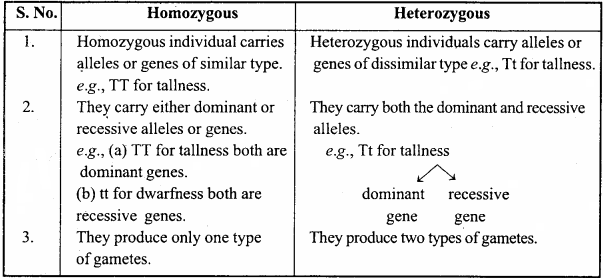
3. Differences between Monohybrid cross and Dihybrid cross:

Question 4.
A diploid organism is heterozygous for 6 loci, how many types of gametes can be produced?
Answer:
Here, we apply the formula 2n where, n = number of loci. The organism is heterozygous for 6 loci.
n = 6
∴ 2n = 26 = 2 x 2 x 2 x 2 x 2 x 2 = 64
Therefore, the organism will produce 64 types of gametes.
Question 5.
Explain the law of dominance using a monohybrid cross.
Answer:
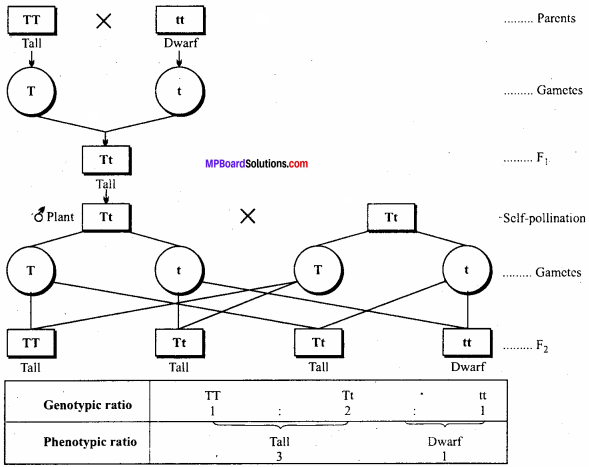
Monohybrid cross:
Crossing between single pair of contrasting character, is known as monohybrid cross, example hybridization between tall and dwarf plant of pea. All offspring of F1, generation of this cross will be tall. In F2 generation tall, hybrid tall and dwarf plants are produced in the ratio of 1: 2 : 1. Thus, the genotypic ratio will be 1 TT : 2 Tt : 1 tt (1 : 2 : 1). The phenotypic ratio of F2 generation will be 3 : 1 (3 TT and 1 tt).
Question 6.
Define and design a test-cross.
Answer:
Crossing of F1 individual having dominant phenotype with its homozygous recessive parent is called test – cross. The test – cross is used to determine whether the individuals exhibiting dominant character are homozygous or heterozygous.
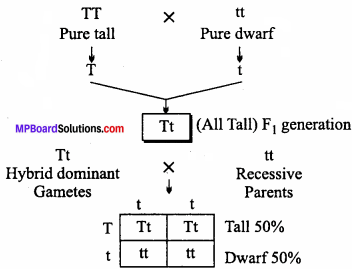
Question 7.
Using a Punnett square, workout the distribution of phenotypic features in the first filial generation after a cross between a homozygous female and a heterozygous male for a single locus.
Answer:
A cross between a homozygous female and heterozygous male follow two conditions:
Condition (1):
Homozygous female – TT (Tall)
Heterozygous male – Tt (Tall)
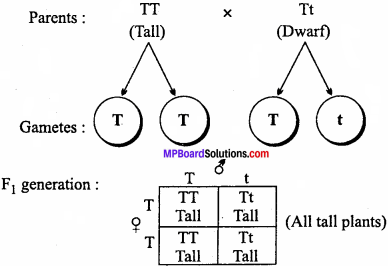
Condition (2):
Homozygous female – tt (Dwarf)
Heterozygous male – Tt (Tall)
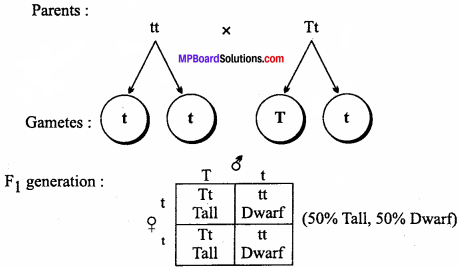
Question 8.
When a cross is made between tall plant with yellow seed (TtYy) and tall plant with green seed (Ttyy), what proportion of phenotype in the offspring could be expected to be:
- Tall and green
- Dwarf and green
Answer:
Parents
![]()
| Ty/ty | Ty | ty |
| TY | TTYy Tall yellow | TtYy Tall yellow |
| Ty | TTyy Tall green | Ttyy Tall green |
| tY | TtYy Tall yellow | ttY y Dwarf yellow |
| ty | Ttyy Tall green | ttyy Dwarf green |
Phenotypic ratio:
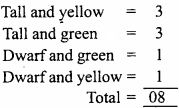
Question 9.
Two heterozygous parents are crossed. If the two loci are linked what would be the distribution of phenotypic features in F1 generation for a dihybrid cross.
Answer:
In case two heterozygous parents, showing linkage result will be:
- Parents BbLl x Bb LI
- Genotype : Blue long Blue long
Phenotype in F1 all the combinations may show parental characters as the genes are completely linked. With all possible genotypes in F1 progeny may exhibit blue long type of phenotype in above case. However, in case of incomplete linkage parental combinations will be less in number.
Question 10.
Briefly mention the contribution of T.H. Morgan in genetics.
Answer:
T.H. Morgan (1866-1945) was given the Nobel prize. His contributions are:
- Morgan worked on fruit fly Drosophila melanogaster and proposed the chromosomal theory of linkage.
- He stated and established that genes are located on the chromosome.
- He established the principle of linkage, crossing over, sex – linked inheritance and discovered the relationship between gene and chromosome.
- He established the technique of chromosome mapping.
- He observed and worked on mutation.
Question 11.
What do you understand by reciprocal cross?
Answer:
Reciprocal cross:
A set of two reciprocal crosses means that the same two ’parents are used in two experiment in such a way that:
- In one experiment, ‘A’ is used as the female parent and ‘B’ is used as the male parent.
- In the other experiment, ‘A’ will be the male parent and ‘B’ the female parent.
Question 12.
What is modifier gene?
Answer:
Modifier genes, instead of making the effects of another gene. A gene can modify the expression of a second gene. In mice, coat colour is controlled by the B gene. The B allele conditions black coat colour and is dominant to the b allele that produces a brown coat.
Question 13.
What do you understand by multiple allele? Explain it with example.
Answer:
Multiple allele:
There are two alternative forms of each trait for the seven pairs of contrasting characters studied by Mendel. It means that there are two alleles for each trait. The first allele will be dominant and other will be recessive. But further studies show that, there are two or more alternative forms of a gene or allele, which are known as multiple alleles.
Example:
1. The skin colour of rabbit is due to the presence of four alleles of a gene.
2. A well known example of multiple allele is ABO blood type in human beings. The four human blood groups ‘A’, ‘B’, ‘AB’ and ‘O’ are the four phenotypes for this trait. Persons having ‘A’ blood group have ‘A’ type of glycoprotein (antigen) coating the red blood cells and persons having ‘B’ blood group have ‘B’ type of glycoprotein (antigen) coating the red blood cells. Persons having ‘AB’ blood group have both type of glycoproteins i.e., ‘A’ and ‘B’ antigens coating the red blood cells, while persons having ‘O’ blood group do not have any glycoprotein on R.B.Cs.
Question 14.
Describe the causes of hereditary variation.
Or
Why does hereditary variations originate?
Answer:
Any change in the structure of gene of an organism will produce heritable variations. The chief causes of these variations are as follows:
1. Genetic recombination:
The exchange of chromosomal segments of genes takes place during reduction division which causes recombination of genes. These recombinant organisms fuse to form zygote. The genetic structure of these zygotes is different from their parents. Adults formed from this zygote will show variations.
2. Changes in the number of chromosomes:
Changes in the number of chromosomes will also cause genetic variations, example, modem varieties of wheat contain 16, 21 and 42 chromosomes. These varieties are produced from its parents having only 7 chromosomes.
3. Changes in the structure of genes:
Changes in the structure of gene will also cause genetic variations, e.g., 30 variety of wheat is the best example of genetic variations. Like this, if any changes in the genes of human being which are related with pigment production, will inhibit the production of these pigments and thus man become albino.
Question 15.
Write down the law of segregation.
Or
Describe Mendel’s law of segregation with example.
Answer:
According to law of segregation, two genes of a character separate and get distributed randomly to different gametes and then to different offspring as per the law of probability. In other words, genes for each trait segregate without mixing. When a cross is made between pure tall pea plant and dwarf pea plant, it gives rise to tall plant in the F1 generation.
On self – breeding both .all and dwarf plants appear in F2 generation in the ratio of 3 : 1. This ratio can be achieved only if the two factors separate at the time of gamete formation and only one factor passes into gamete. Therefore, this law is also called as law of purity of gametes.
Question 16.
Explain recessive epistasis with example.
Answer:
Recessive epistasis (9 : 3 : 4):
In case of recessive epistasis, the epistatic gene is recessive to its own allele. Thus, in this condition, the epistatic gene can have its inhibiting influence only when it is in homozygous condition. The inheritance of body colour in mice is an example of recessive epistasis. It may have three body colours i.e., agouti, coloured and albino.
The agouti body colour is controlled by a dominant gene ‘A’. Another dominant gene ‘C’ gives coloured body only in the absence of dominant ‘A’ gene. The expression of agouti body colour by gene ‘C’ is inhibited by recessive gene ‘C’ Therefore, even in the presence of ‘A’ gene, the mice develop albino body colour if recessive genes ‘CC’ are present.
Question 17.
Why are the women normally carrier of sex – linked diseases? Write with example.
Or
Men are generally suffering from colourblindness but women are only carriers of this disease. Explain the reason.
Answer:
The gene for colour – blindness is recessive and carried by X – chromosomes. A colourblind man has a single recessive gene (XcY). The gene for normal vision is dominant. When sex chromosomes (X) of a man contains genes for colourblindness (Xc), they express itself and produce colourblindness in them.
A carrier woman contains one recessive gene which remains suppressed due to presence of the dominant gene of normal vision on the other sex chromosomes (XcX). These women play important role in the conduction of genes of colourblindness. Hence, they are carrier (XcX). Women become colourblind only when its both chromosomes contain the genes of colourblindness (XcXc).
Question 18.
When a colourblind man is married with a normal woman, then work – out the progeny of these parents with the help of diagram.
Answer:
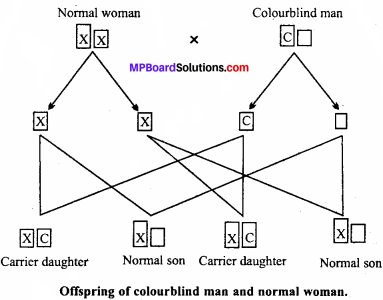
If a normal woman is married with a colourblind man then in F1 generation carrier daughters and normal sons are formed.
Question 19.
What is Down’s syndrome?
Answer:
Down’s Syndrome:
It is a common human karyotype in which trisomy occur at 21st chromosome. This type of person contains 47 chromosomes. It was first studied by Down (1866) and was popularly known as Mongolian idiocy because the facial features of persons suffering from Down’s syndrome resembled Mongolians.They have broad forehead, flat hands, short neck, projecting lips, stubby fingers and long extending tongue. The Mongoloid individuals are feeble minded and their mental age never exceeds to those of six to seven year’s old children.
Question 20.
What is point mutation? Give one example.
Answer:
Point mutation is a gene mutation that arises due to change in a single base pair of DNA.
Example:
Sickle – cell anaemia.
A substitution of a single nitrogen base at the sixth codon of the β – globin chain of haemoglobin molecule causes the change in the shape of the R.B.C. from biconcave disc to elongated shaped, structure which results is sickle cell anaemia.
Question 21.
Explain the inheritance of haemophilia when a haemophilic woman is married with normal man with the help of diagram.
Answer:
When a haemophilic woman is married with a normal man, all the boys offspring will be haemophilic whereas all the girls offspring will be carrier of haemophilia. In other words, 50% offsprings will be haemophilic and 50% offsprings will be carrier.
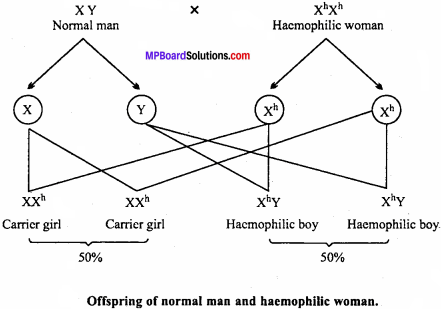
Principles of Inheritance and Variation Long Answer type Questions
Question 1.
Explain complementary gene (9 : 7) with example.
Answer:
Complementary genes (9 : 7):
The complementary genes are the two pairs of non – allelic genes which are present on separate loci and interact to produce only one phenotypic trait but either of them if present alone produces the phenotypic trait in the absence of other. The example of complementary gene interaction was provided by Bateson and Punnet in sweet pea (Lathyrus odoratus).
He demonstrated that two dominant genes ‘C’ and ‘P’ are responsible for the development of purple coloured flowers in a plant of sweet pea. The dominant gene ‘P’ or ‘C’ in homozygous (PP and CC) and heterozygous (Pp and Cc) state are unable to produce their effect if they are present alone. They observed that when two white flowered plants are crossed with each other, the F1have coloured flowers.
This is due to the fact that crossing between two white flowered plants brought together two non – allelic dominant genes in F1. On intercrossing, these F1 progenies produced coloured and white flowered plants in 9 : 7 ratio
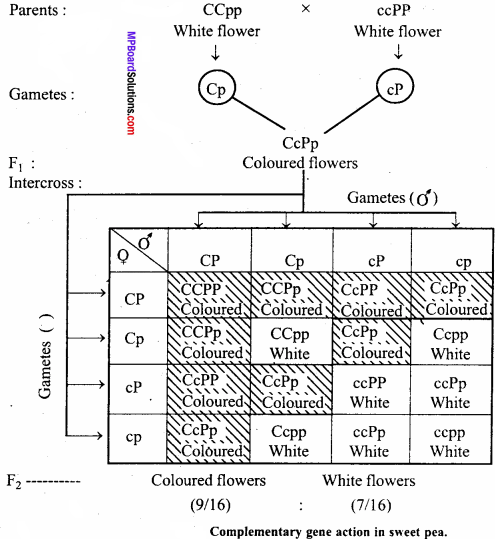
Question 2.
Explain the law of independent assortment of characters.
Answer:
The gametes and zygotes usually carry several chromosomes which are different in appearance and perhaps in contents. The genotype consists of many pairs of genes. Although chromosomes were not known to Mendel yet he felt the need of finding out how different characters would behave in relation to each other in their passing from generation to generation. This also could be demonstrated with two pairs of opposite characters. Such a cross which involves two character differences separable in inheritance is termed as a dihybrid cross. For example, taking parents round yellow pea and a wrinkled green pea (Fig.).
- Round, yellow (RY) : Dominant characters
- Wrinkled, green (ry) : Recessive characters.
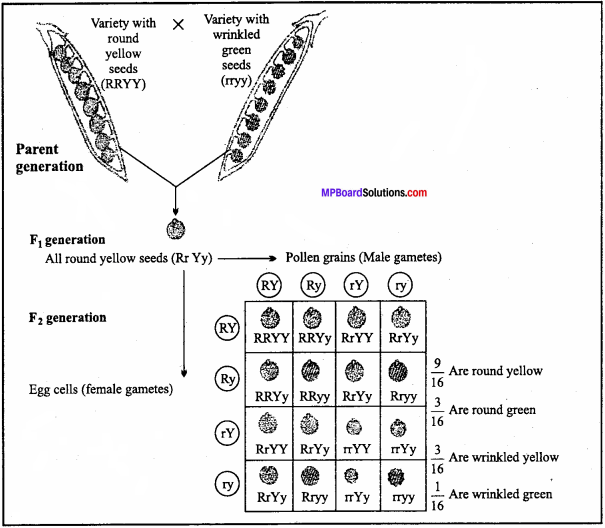
Question 3.
What is crossing over?
Or
Explain crossing over.
Or
Write the process of crossing over with diagram that occurs during meiosis.
Answer:
Exchange of chromosomal segments between two homologous chromosomes during diplotene of meiosis I division is called as crossing over. When homologous chromosomes tend to start their separation due to repulsion during diplotene, they are bounded in some places. These places are called Chiasmata. Due to the process of terminalization chiasmata start to move along the length of the chromosome from the centromere.
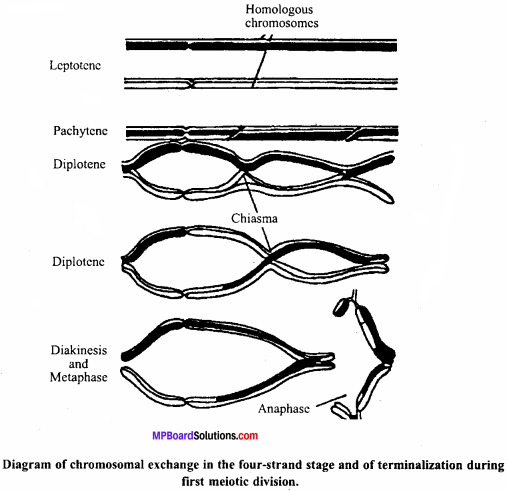
The terminalization of chiasmata will result in the formation of ‘X’ – shaped configuration in which breakage of chromosomal segments takes place, then these segments are reunited in a manner in which the segments of non – sister chromosomes are exchanged. This exchange of chromosomal segments or genes of homologous chromosomes is termed as crossing over. This process is very important because it originates new characters and causes variations in the organisms.
Question 4.
What is pedigree analysis? Suggest how such an analysis can be useful.
Answer:
1. Pedigree analysis is an important method to study human genetics because:
- Human beings cannot be crossed at will.
- The generation time is very long (about 20 years).
- The number of offspring produced is small.
2. For pedigree analysis, information about the family’s history for a particular trait is first collected.
3. The expression of the trait is constructed in the form of a family tree.
4. In a pedigree, by convention:
- Circles denote females.
- Squares denote males.
- Solid symbols represent the trait being studied.
- Open symbols denote normal form.
- Symbol with a cross line indicates a carrier for a recessive trait.
- Parents are joined by horizontal lines.
- The offsprings are connected to a horizontal line below the parents in the order of birth and the line is
- connected to the parental line by a vertical line.
5. Pedigree analysis can yield valuable information about the possible genetic make up of a person for a trait.
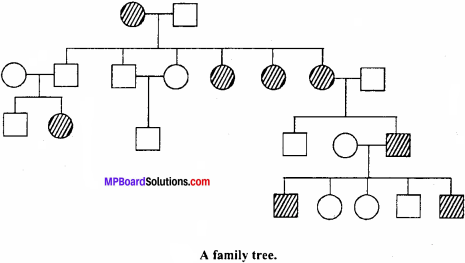
Functions:
From pedigree analysis, we can find out, what kind of characters a new born baby is having. If this practice is done before marriage, we can be safe from many problems. It helps in finding the solution of hereditary problems.
Question 5.
How is sex – determined in human beings?
Answer:
Each cell of human beings contains 23 pairs of chromosomes. Out of 23 pairs, 22 pairs are similar and called as autosomes whereas 23rd pair is different from autosomes which
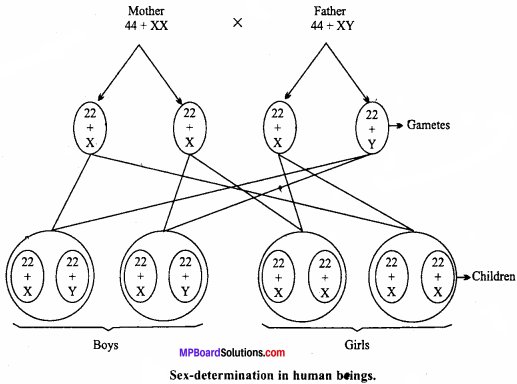
are called as sex – chromosomes because they play important role in the determination of sex. In the cells of man, there are two types of sex chromosomes (XY) present while the cells of women have two similar sex chromosomes (XX). After spermatogenesis two types of sperms are formed
- One having 22 + X chromosomes and
- Other having 22 + Y chromosomes.
But in woman there is only one type of ovum formed which contains 22 + X chromosomes only. At the time of fertilization when a sperm having 22 + X chromosomes is fused with ovum they produce a female child having two ‘XX’ chromosomes. But when a sperm having 22 + Y chromosomes is fused with ovum then resulting offspring will contain ‘XY’ sex chromosomes hence, it is male child.
Question 6.
A child has blood group ‘O’. If the father has blood group ‘A’ and mother blood group ‘B’. Work – out the genotypes of the parents and the possible genotypes of the other offsprings.
Answer:
- Father’s blood group A – IAIA or IAIO
- Mother’s blood group B – IBIB or IBIO
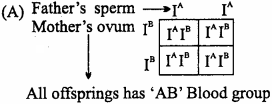
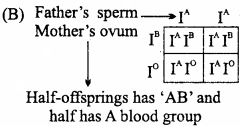
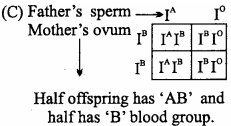
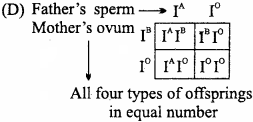
Question 7.
Explain the following terms with example:
- Co – dominance
- Incomplete dominance.
Answer:
1. Co – dominance:
When the F1 generation resembles both the parents and both the parental characters are expressed simultaneously, then a phenomenon is called co – dominance.
For example:
‘AB’ type blood group is possible when allele ‘A’ and ‘B’ come to – gether and since, both the alleles are expressing their effects in F1 generation, they are co – dominants.
2. Incomplete dominance:
It is a condition which occurs between dominant alleles in which one may be slightly more dominant than the other.
Example :
As in Mirabilis jalapa if a red flowered plant is crossed with white flowered plant, then the resulting F1 hybrid bears pink coloured flowers only. This intermediate inheritance is called incomplete dominance. The F1pink flowered plants when self – pollinated give F2 progeny which contains red, pink and white flowers in the ratio of 1 : 2 : 1. The phenotypic and genotypic ratio is same in case of incomplete dominance.
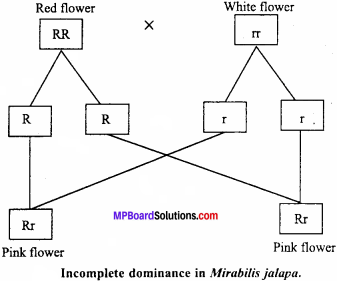
Question 8.
Explain the chromosomal theory of linkage.
Answer:
Chromosomal theory of linkage was produced by Morgan and Castle in 1911. The main points of this hypothesis are:
- Linked genes are found on a chromosome.
- The strength of linkage depends upon the distance between genes.
- Two nearest genes exhibit linkage while genes exhibit crossing over.
- All linked genes are found on a particular place on the chromosomes and are arranged in a linear fashion.
Question 9.
Mention any two autosomal genetic disorders with their symptoms.
Answer:
Phenylketonuria:
This inborn error of metabolism is also inherited as the auto – somal recessive trait. The affected individual lacks an enzyme that converts the amino acid phenylalanine into tyrosine. As a result, this phenylalanine is accumulated and converted into phenyl pyruvic acid and other derivatives. Accumulation of these in brain results in mental retardation.
Sickle cell anaemia:
This is an autosome liked recessive trait that can be transmitted from parents to the offspring when both the partners are carrier for the gene of heterozygous.
Question 10.
What is linkage? It is of how many types?
Answer:
Linkage:
The tendency of genes inherited together, without independent assortment is called linkage and such genes are linked genes. Such genes are closely situated showing a strong attraction between them. Linkage always reduces the changes of crossing over. All those genes which are located in the single chromosome from one linkage group. The linkage groups correspond to the haploid number of chromosomes of a species or number of chromosomes pairs. Thus, the linkage groups in maize would be 10, 7 in pea, 4 in Drosophila, 23 in man etc.
Types of Linkages:
T.H. Morgan along with Castle working on Drosophila discovered the following types of linkage:
1. Complete linkage:
It is the phenomenon in which parental combination of characters appear together for two or more generations continuously.
Example:
Genes for bent wings and shaven bristles in Drosophila melanogaster.
2. Incomplete linkage:
n this phenomenon, the linked genes may remain together for one generation only and have chances of separation in subsequent generation, because of crossing over.
Example:
Genes for grey body and long wings characters.